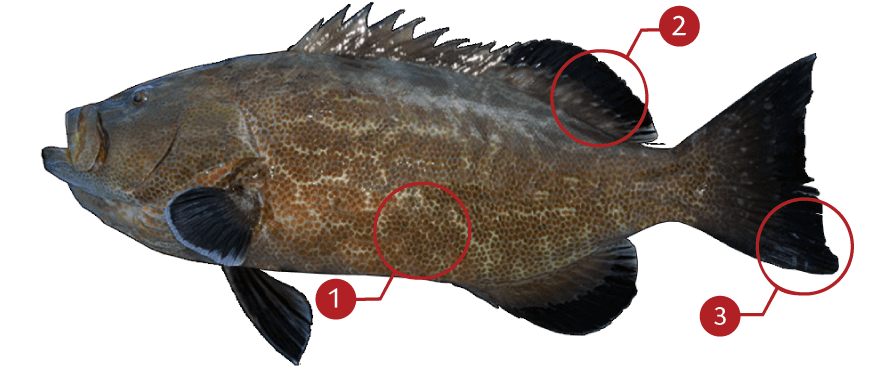BLACK GROUPER
How to identify a Black Grouper
Coloration in the black grouper can vary, but their sides typically exhibit a rectangular pattern of dark grey rectangular blotches. The edges of the second dorsal, caudal, and anal fins are also dark black. The black grouper has olive or gray body coloration along with small hexagonal bronze spots on its head and lower side. The borders of the soft dorsal, anal, and caudal fin are black or bluish; sometimes there is an orange edge along the pectoral fins. Juveniles feed mainly on crustaceans, while adult fish prefer smaller baitfish. The black grouper is a large hearty fish with a protruding lower jaw. It has an oblonged body shape and rounded margins on both the dorsal and anal fins. The caudal fin is squared-off, and the dorsal fin has 11 spines and 15-17 rays. The preopercule is rounded without the presence of a notch, which distinguishes it from the gag grouper (Mycteroperca microlepis). Black groupers can reach up to 52 inches (133 cm) in length and can weigh up to 179 pounds (81 kg). Most of the black grouper that are caught average a little over 2 feet in length (70 cm). They can live over 30 years, but most of the growth occurs during the first ten years of life.The front teeth of the black grouper are well-developed canine teeth. Groupers have several sets of strong, slender teeth that act as raspers. These teeth are not used to tear flesh as with the barracudas and sharks, but rather to prevent small fish from escaping.Black grouper are also protogynous hermaphrodites. This means that all of the species are born as females. Later in life, some of the fish will change from female to male so the population can reproduce. Those black groupers that go through this process do so when they reach about 39 - 48 inches.
Where to catch Black Grouper
They can be found on offshore wrecks and reefs from North Carolina south to Florida and are also common in the Gulf of Mexico.
IDENTIFICATION

| |
Olive or gray body coloration along with small hexagonal bronze spots on its head and lower side |
| |
The dorsal fin has 11 spines and 15-17 rays |
| |
The edges of the second dorsal, caudal, and anal fins are also dark black |
TARGET AREAS
|
|

